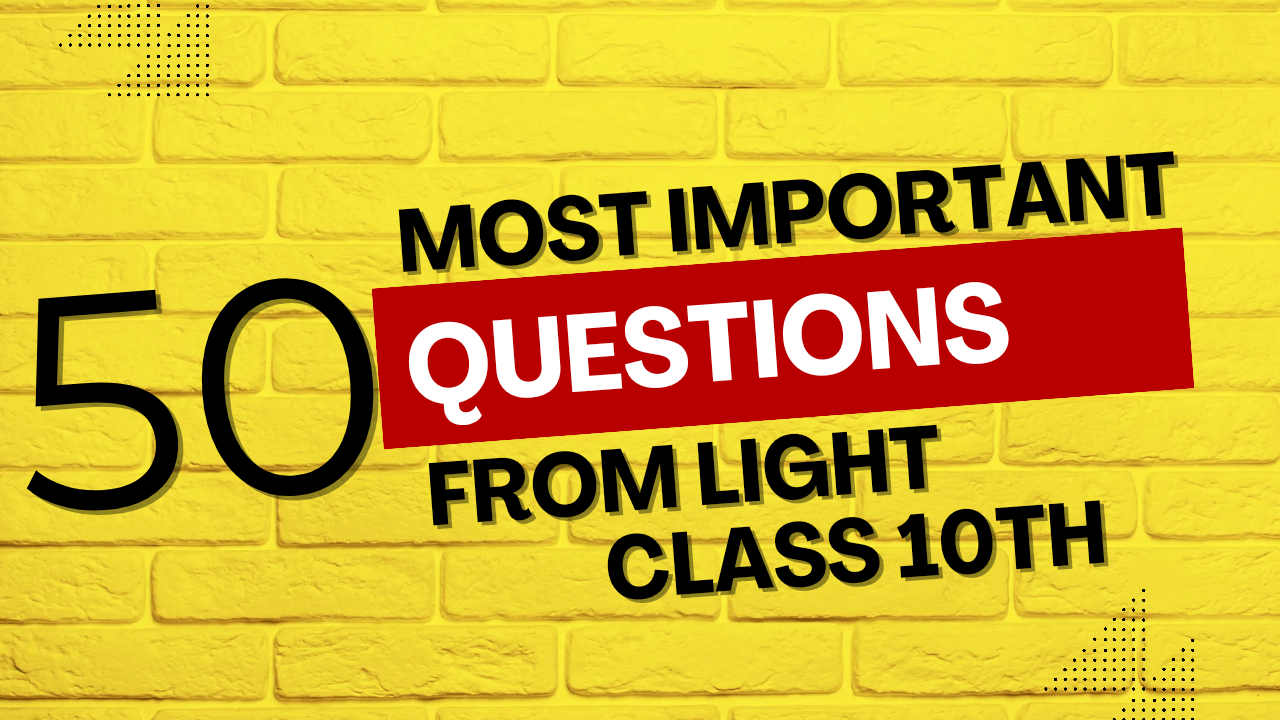Short Questions of Light with Answer are as under:
What is the principal focus of a concave mirror?
Answer: The principal focus of a concave mirror is the point on its principal axis where light rays parallel to the principal axis converge after reflecting from the mirror.
Define the focal length of a concave mirror.
Answer: The focal length of a concave mirror is the distance between the mirror’s pole and its principal focus.
What is the magnification produced by a concave mirror if an object is placed at its focus?
Answer: If an object is placed at the focus of a concave mirror, the magnification is theoretically infinite, as the image is formed at infinity.
What type of image is formed by a convex mirror regardless of the position of the object?
Answer: A convex mirror always forms a virtual, erect, and diminished image regardless of the position of the object.
Why are convex mirrors used as rearview mirrors in vehicles?
Answer: Convex mirrors are used as rearview mirrors in vehicles because they provide a wider field of view, allowing the driver to see more area behind the vehicle.
Describe the image formed by a concave mirror when the object is placed between the pole and the focus.
Answer: When an object is placed between the pole and the focus of a concave mirror, the image formed is virtual, erect, and enlarged.
What is the relationship between the radius of curvature (R) and the focal length (f) of a spherical mirror?
- Answer: The relationship between the radius of curvature (R) and the focal length (f) of a spherical mirror is given by 𝑅=2𝑓.
What is the nature of the image formed by a plane mirror?
Answer: The image formed by a plane mirror is always virtual, erect, and of the same size as the object. The image is laterally inverted and appears to be at the same distance behind the mirror as the object is in front of it.
What is a real image?
Answer: A real image is an image that is formed when light rays actually converge at a point. Real images can be projected onto a screen and are inverted.
What is a virtual image?
Answer: A virtual image is an image that is formed when light rays appear to diverge from a point behind the mirror. Virtual images cannot be projected onto a screen and are erect.
What is lateral inversion?
Answer: Lateral inversion is the phenomenon in which the left side of an object appears on the right side of its image, and the right side of the object appears on the left side of its image. This occurs with plane mirrors.
Explain why a convex mirror always forms a virtual image.
Answer: A convex mirror always forms a virtual image because the reflected rays diverge. When these diverging rays are extended backward, they appear to come from a point behind the mirror. Thus, the image formed is always virtual, erect, and diminished.
What type of mirror is used in a solar furnace and why?
Answer: A concave mirror is used in a solar furnace because it can concentrate sunlight at its focus, producing high temperatures necessary for the furnace to operate.
How can you distinguish between a concave and a convex mirror without touching them?
Answer: You can distinguish between a concave and a convex mirror by observing the image formed. A concave mirror can form a real, inverted, and enlarged image of an object placed close to it, while a convex mirror will always form a virtual, erect, and diminished image.
What is the nature of the image formed by a concave mirror when the object is placed at the center of curvature?
Answer: When an object is placed at the center of curvature of a concave mirror, the image formed is real, inverted, and of the same size as the object. The image is also formed at the center of curvature.
Define refraction of light.
Answer: Refraction of light is the bending of light as it passes from one transparent medium to another of different optical density, due to a change in its speed.
State Snell’s law of refraction.
- Answer: Snell’s law of refraction states that the ratio of the sine of the angle of incidence to the sine of the angle of refraction is a constant for a given pair of media.
- Mathematically, it is expressed as: sin𝑖/sin𝑟=constant=𝑛
- where 𝑖 is the angle of incidence, r is the angle of refraction, and 𝑛 is the refractive index of the second medium with respect to the first medium.
What is the refractive index?
Answer: The refractive index of a medium is the ratio of the speed of light in vacuum (or air) to the speed of light in that medium. It is a measure of how much the light is bent or refracted when entering the medium.
Explain why a pencil appears bent when partially submerged in water.
Answer: A pencil appears bent when partially submerged in water due to refraction. The light rays from the submerged part of the pencil bend as they pass from water to air, causing the pencil to appear bent at the water’s surface.
Why does a swimming pool appear shallower than it actually is?
Answer: A swimming pool appears shallower than it actually is because of the refraction of light. Light rays from the bottom of the pool bend away from the normal as they move from water to air, making the bottom appear closer to the surface.
What is the relationship between the refractive indices of two media and the speed of light in those media?
Answer: The refractive index 𝑛n of a medium is inversely proportional to the speed of light 𝑣v in that medium. Mathematically, it is given by: n = c/v
where 𝑐 is the speed of light in vacuum and 𝑣 is the speed of light in the medium
What happens to the speed of light when it travels from a rarer medium to a denser medium?
Answer: When light travels from a rarer medium to a denser medium, its speed decreases. This decrease in speed causes the light to bend towards the normal.
Explain why light bends when it enters from one medium to another.
Answer: A ray of light bends away from the normal when it enters a rarer medium from a denser medium because the speed of light increases in the rarer medium, causing the light to bend away from the normal.
What is an optical density? How is it different from mass density?
Optical density is a measure of how much a medium slows down the speed of light. It is different from mass density, which is the measure of mass per unit volume. Optical density affects the refractive index, while mass density does not.
What happens to the direction of a light ray when it travels along the normal to the boundary between two media?
Answer: When a light ray travels along the normal to the boundary between two media, it passes straight through without bending. There is no refraction in this case.
What is the focal length of a lens?
Answer: The focal length of a lens is the distance between the optical center of the lens and its principal focus.
What is a convex lens?
Answer: A convex lens is a converging lens that is thicker at the center than at the edges. It causes parallel light rays to converge to a point.
What is a concave lens?
Answer: A concave lens is a diverging lens that is thinner at the center than at the edges. It causes parallel light rays to diverge as if they are originating from a point.
What is the principal axis of a lens?
Answer: The principal axis of a lens is an imaginary straight line that passes through the optical center and the centers of curvature of the lens surfaces.
What is the optical center of a lens?
Answer: The optical center of a lens is a point on the principal axis of the lens through which light passes without being deviated.
Define the term ‘power of a lens.’
Answer: The power of a lens is the measure of its ability to converge or diverge light. It is defined as the reciprocal of the focal length (in meters) and is measured in diopters (D).
What is the power of a lens with a focal length of 50 cm?
Answer: The power of a lens with a focal length of 50 cm (0.5 meters) is:𝑃=1/0.5=2 D.
Describe the nature of the image formed by a concave lens regardless of the position of the object.
Answer: A concave lens always forms a virtual, erect, and diminished image, regardless of the position of the object.
What happens to the focal length of a lens when it is placed in a medium with a refractive index equal to that of the lens?
Answer: When a lens is placed in a medium with a refractive index equal to that of the lens, its focal length becomes infinite, and it behaves as if it were a plane glass sheet.
Explain why a convex lens is also called a converging lens.
Answer: A convex lens is called a converging lens because it bends (refracts) parallel incoming light rays to meet at a point on the principal axis called the focal point.
Explain why a concave lens is also called a diverging lens.
Answer: A concave lens is called a diverging lens because it spreads out (diverges) parallel incoming light rays, making them appear to originate from a point on the principal axis.
What are the principal foci of a lens?
Answer: The principal foci of a lens are the points on the principal axis where light rays parallel to the principal axis converge (for a convex lens) or appear to diverge (for a concave lens) after passing through the lens.
How is the magnification related to the nature of the image formed by a concave mirror?
Answer: For a concave mirror:If the magnification (𝑚m) is negative, the image is real and inverted.If the magnification (𝑚m) is positive, the image is virtual and erect.
What does a magnification greater than 1 indicate?
Answer: A magnification greater than 1 indicates that the image is larger than the object.
What does a magnification less than 1 indicate?
Answer: A magnification less than 1 indicates that the image is smaller than the object.
What does a magnification of 1 indicate?
Answer: A magnification of 1 indicates that the image is the same size as the object.
Describe the nature of the image formed by a convex mirror in terms of magnification.
Answer: A convex mirror always forms a virtual, erect, and diminished image. The magnification is always positive and less than 1.
Describe the image formed by a concave mirror when the magnification is -1.
Answer: When the magnification is -1, the image formed by a concave mirror is real, inverted, and of the same size as the object. This occurs when the object is placed at the center of curvature.
What does it mean if the magnification of a mirror is zero?
Answer: A magnification of zero is theoretical and implies that the image has no height, which is not possible in practical scenarios. It suggests that the image would be at an infinite distance from the mirror, often considered an undefined condition in real-life optics.
Explain why the refractive index of a medium is always greater than or equal to 1.
Answer: The refractive index of a medium is always greater than or equal to 1 because the speed of light in a medium is always less than or equal to the speed of light in vacuum. Since the refractive index is the ratio of these two speeds, it cannot be less than 1.
What is the refractive index of air approximately?
Answer: The refractive index of air is approximately 1.0003, which is very close to 1 because the speed of light in air is nearly the same as in a vacuum.
Explain why a diamond sparkles more than glass.
Answer: A diamond sparkles more than glass because it has a higher refractive index (about 2.42) compared to glass (about 1.5). This causes greater bending and dispersion of light inside the diamond, leading to more total internal reflections and hence more sparkle.




